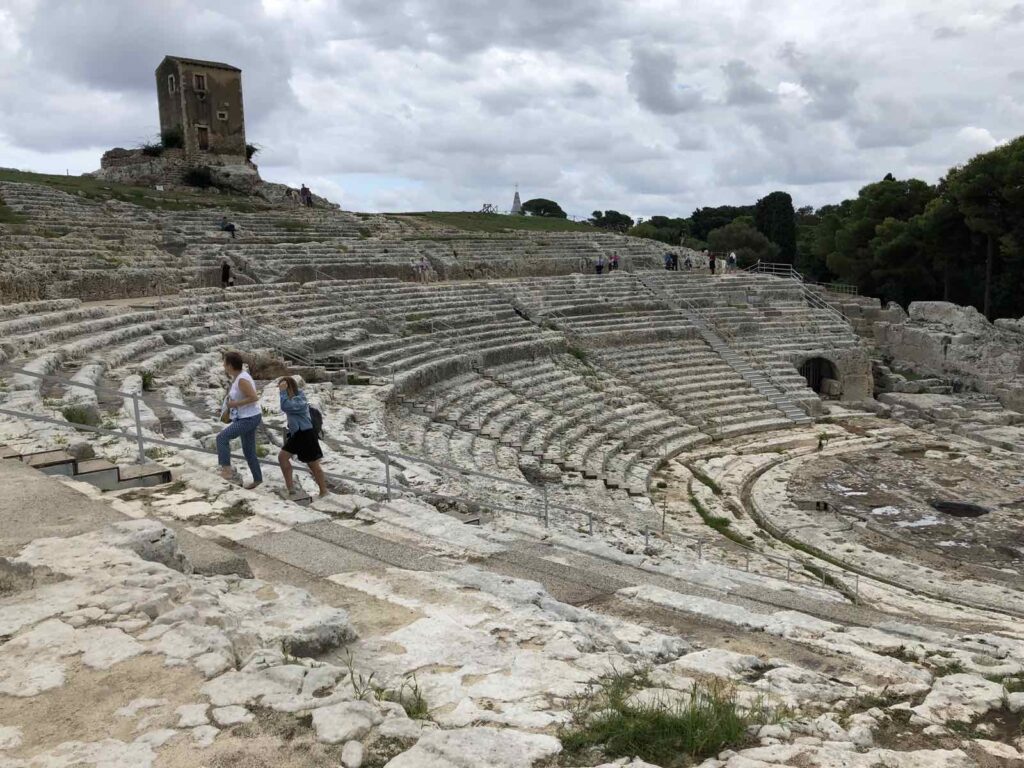The enchanting city of Syracuse, locally known as Siracusa — and not to be confused with the university town of Syracuse in upstate New York — lies along the picturesque shores of the Ionian Sea in the stunning fabled Italian island of Sicily.
The 2,700-year-old site, bursting with influences in all aspects of life of the Greeks and the Romans, is a treasure trove rich in ancient history and heritage, arts and architecture, culture and traditions, which beckons travelers from all over the globe.
We were no exception. Join us on our memorable journey to the birthplace of Archimedes, the legendary mathematician and engineer — the region’s pride — where we visited its hidden gems, each offering an eye-opening glimpse into the tapestry of its past, blending beautifully with its present.
Here are five discoveries we wish to share:
Teatro Greco: Ancient Echoes
Our first stop was an olden Greek theater which stands witness to the history and antiquity of centuries-gone-by. Built in the fifth century BC, it once hosted plays by renowned playwrights then-and-now such as Aeschylus and Sophocles. Carved into the rocky hillside, this open-air theater is one of the most well-preserved in the world.
Today’s spectators continue to admire its grandeur and are bewildered by its acoustics, while imagining the performances that once enthralled audiences in this very same spot. The annual Greek Theater Festival carries on the spirit, as modern adapted productions preserve the essence of the past, while captivating attendees just as they did millennia ago.

Duomo di Siracusa: Architectural Harmony
A brief walk took us to the Duomo di Siracusa — known as the Cathedral of Syracuse — that stands tall in all its glory and grandeur. This magnificent church, dedicated to the Nativity of the Virgin Mary, seamlessly blends several architectural flairs, reflecting the city’s diverse days of yore.
Originally a Greek temple, the Duomo was later converted into a Christian shrine during the Byzantine era and subsequently transformed into a mosque during the Arab occupation. It wasn’t until the Norman conquest, which lasted from the years 999 to 1139, when it regained its Christian identity. This fusion of arts and cultural influences and architectural elements, such as the ancient Greek columns, ornate Baroque façade, and age-old frescoes create an awe-inspiring ambience within its hallowed halls.

Saint Lucy’s Chapel: Martyred Devotion
Within the region’s main house of prayer is a rather tiny, yet nevertheless popular, Saint Lucy’s Chapel, the patroness of the area. Venerated with unwavering dedication and devotion, her life story, one of faith and martyrdom, is deeply ingrained in the lives of the hamlet’s inhabitants.
The chapel’s serene ambiance provides a tranquil space for contemplation and meditation, with a possible rediscovery of oneself once again. Pilgrims and tourists alike come to pay their respects and seek solace in her presence. The altar is adorned with exquisite religious art, yet the main draw was the breathtaking painting of Saint Lucy. Other relics include her very own tunic and veil, on display for all to witness.

Fountain of Diana: Mythical Oasis
We then found ourselves at the city’s historic center, by the Fountain of Diana. It stands as a symbol of grace and pays tribute to the Roman goddess of hunting and the moon.
With intricate sculptures amidst serene surroundings, it invited us for a moment of respite as we reflected on the timeless beauty of Syracuse. Its peaceful waters provide a welcome contrast to the bustling streets, making it a delight for both locals and transients alike.

Ortigia Island: Mediterranean Getaway
Our final stop was Ortigia Island, a true Mediterranean haven. Connected to the mainland by two bridges, the isle is a melodious blend of scenic sights and antique charm.
We strolled through its alleys and pathways lined with colorful buildings and hidden piazzas that came alive with local life in the evenings. The islet is also home to the iconic Fountain of Arethusa, where freshwater springs mingle with saltwater, creating a font of lush greenery. Legend has it that the nymph Arethusa shifted into a spring to escape the advances of the river god Alpheus, creating this enchanting refuge.
As if water around us were not enough, the rains poured relentlessly and before long – flash floods everywhere. We couldn’t do anything but purchase rain boots! Picture us as the unstoppable team, ready to search and experience more rare finds.
These are our five postcards. What’s yours?
